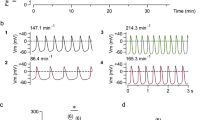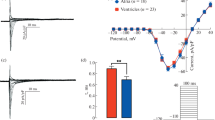Abstract
Voltage clamp experiments were carried out in order to study the mechanism of the ACh action in the rabbit S-A node cell. The following results were obtained:
-
1.
The reversal potential of the ACh-induced current behaved like a potassium electrode, confirming that the ACh-operated channels pass potassium ions selectively.
-
2.
On depolarizing voltage jumps the ACh-induced current showed an instantaneous peak from which the current decayed to a new steady level (relaxation). On hyperpolarizing voltage jumps the initial step change in current was followed by a gradual increase.
-
3.
The time course of the current change on voltage jumps was well fitted by a single exponential and the time constant became longer as the membrane potential was increased.
-
4.
The instantaneous I–V curve was linear while in the steady state the curve became flatter at low negative membrane potentials and steeper at high negative membrane potentials.
The results suggest that ACh opens a specific potassium channel when the drug is bound to the muscarinic receptor. The opening and closing rate constants for this potassium channel depend on the membrane potential in such a way that on depolarizing voltage jumps the fraction of open channels gradually decreases and on hyperpolarization the fraction increases.
Similar content being viewed by others
References
Adams, P. R.: Kinetics of agonist conductance changes during hyperpolarization at frog endplates. Br. J. Pharmacol.53, 308–310 (1974)
Anderson, C. R., Stevens, C. F.: Voltage clamp analysis of acetylcholine produced current fluctuations at frog neuromuscular junction. J. Physiol. (Lond.)235, 655–691 (1973)
Beeler, G. W., Reuter, H.: Reconstruction of the action potential of ventricular myocardial fibres. J. Physiol. (Lond.)268, 177–210 (1977)
Dreyer, F., Peper, K.: Iontophoretic application of acetylcholine: Advantages of high resistance micropipettes in connection with an electronic current pump. Pflügers Arch.348, 263–272 (1974)
Giles, W. R., Noble, S. J.: Changes in membrane currents in bullfrog atrium produced by acetylcholine. J. Physiol. (Lond.)261, 103–123 (1976)
Glitsch, H. G., Pott, L.: Effects of acetylcholine and parasympathetic nerve stimulation on membrane potential in quiescent guinea pig atria. J. Physiol. (Lond.)279, 655–668 (1978)
Harris, E. J., Hutter, O. F.: The action of acetylcholine on the movements of potassium ions in the sinus venosus of the heart. J. Physiol. (Lond.)133, 58P (1956)
Hutter, O. F.: Ion movement during vagus inhibition of the heart. In: Nervous inhibition (E. Florey, ed.), pp. 114–123. Oxford: Pergamon Press 1961
Ikemoto, Y., Goto, M.: Nature of the negative inotropic effect of acetylcholine on the myocardium. An elucidation of the bullfrog atrium. Proc. Jap. Acad.51, 501–505 (1975)
Katz, B., Miledi, R.: The statistical nature of the acetylcholine potential and its molecular components. J. Physiol. (Lond.)224, 665–699 (1972)
McAllister, R. E., Noble, D., Tsien, R. W.: Reconstruction of the electrical activity of cardiac Purkinje fibers. J. Physiol. (Lond.)251, 1–59 (1975)
McDonald, T. F., Trautwein, W.: The potassium current underlying delayed rectification in cat ventricular muscle. J. Physiol. (Lond.)274, 217–246 (1978)
Neher, E., Sakmann, B.: Noise analysis of drug-induced voltage clamp currents in denervated frog muscle fibers. J. Physiol. (Lond.)258, 705–729 (1976)
Noble, D., Tsien, R. W.: The kinetic and rectifier properties of the slow potassium current in cardiac Purkinje fibers. J. Physiol. (Lond.)195, 185–214 (1968)
Noble, D., Tsien, R. W.: Outward membrane currents activated in the plateau range of potentials in cardiac Purkinje fibers. J. Physiol. (Lond.)200, 205–231 (1969)
Noma, A., Irisawa, H.: Membrane currents in the rabbit sinoatrial node cell as studied by the double microelectrode method. Pflügers Arch.364, 45–52 (1976a)
Noma, A., Irisawa, H.: A time- and voltage-dependent potassium current in the rabbit sinoatrial node cell. Pflügers Arch.366, 251–258 (1976b)
Noma, A., Trautwein, W.: Fluctuations in ACh-induced potassium current in the rabbit S-A node cell. in preparation (1979)
Noma, A., DiFrancesco, D., Trautwein, W.: Dose-response curve for acetylcholine (ACh) and carbamylcholine (CCh) in the rabbit SA-node. Pflügers Arch.377, R4 (1978)
Rayner, B., Weatherall, N.: Acetylcholine and potassium movements in rabbit auricles. J. Physiol. (Lond.)146, 392–409 (1959)
Reuter, H.: Localization of beta adrenergic receptors and effects of noradrenaline and cyclic nucleotides on action potentials, ionic currents and tension in mammalian cardiac muscle. J. Physiol. (Lond.)242, 429–451 (1974)
Ten Eick, R., Nawrath, H., McDonald, T. F., Trautwein, W.: On the mechanism of the negative inotropic effect of acetylcholine. Pflügers Arch.361, 207–213 (1976)
Trautwein, W., Dudel, J.: Zum Mechanismus der Membranwirkung des Acetylcholin an der Herzmuskelfaser. Pflügers Arch. ges. Physiol.266, 324–334 (1958)
Tsien, R. W.: Effects of epinephrine on the pacemaker potassium current of cardiac Purkinje fibers. J. Gen. Physiol.64, 293–319 (1974)
Author information
Authors and Affiliations
Additional information
This work was supported by the Deutsche Forschungsgemeinschaft, SFB 38, Membranforschung, project G.
Rights and permissions
About this article
Cite this article
Noma, A., Trautwein, W. Relaxation of the ACh-induced potassium current in the rabbit sinoatrial node cell. Pflugers Arch. 377, 193–200 (1978). https://doi.org/10.1007/BF00584272
Received:
Issue Date:
DOI: https://doi.org/10.1007/BF00584272




